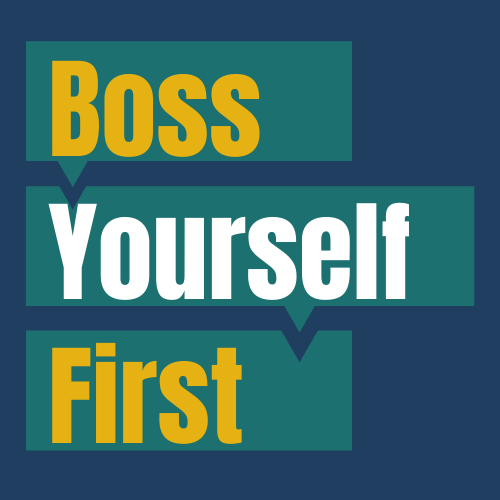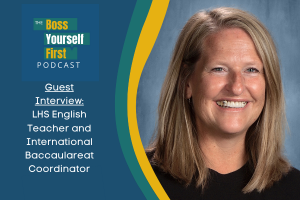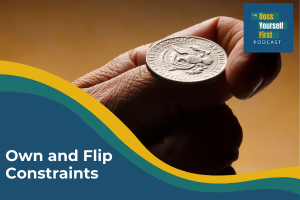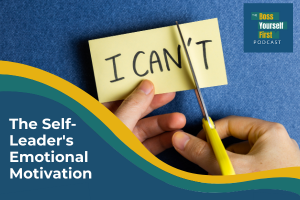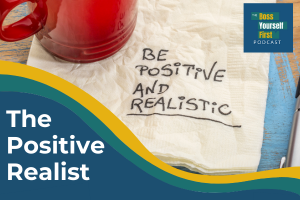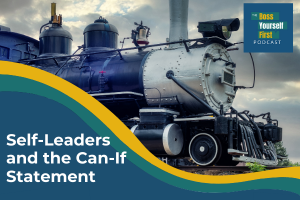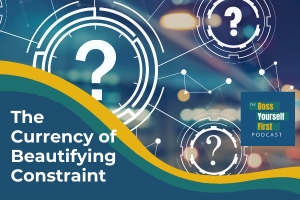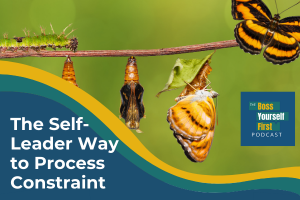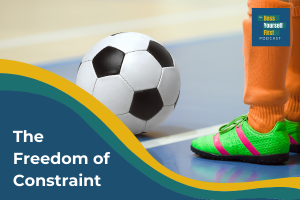Episode Transcript
Boss Yourself First –
BYF Season 2 Episode 5
Hey friends,
I hope you are having a great week and I hope you took the challenge from our last episode and created you can if questions. This week we are focusing on creating abundance to leverage our constraint. You remember how we’ve been developing our question thinking. Now we’re turning our attention to abundance thinking.
Abundance thinking enables us to approach our can if statements with openness and creativity. Processing constraints in the victim stage means giving way to feelings and thoughts of scarcity.
Stephen Covey, author of the Seven habits of highly effective people says “Most people are deeply scripted in what I call the Scarcity Mentality. They see life as having only so much, as though there were only one pie out there. And if someone were to get a big piece of the pie, it would mean less for everybody else.
The Scarcity Mentality is the zero-sum paradigm of life. People with a Scarcity Mentality have a very difficult time-sharing recognition and credit, power or profit – even with those who help in the production. They also have a very hard time being genuinely happy for the success of other people.”
And then Covey contrast that with an abundance mentality, he says,
“The Abundance Mentality, on the other hand, flows out of a deep inner sense of personal worth and security. It is the paradigm that there is plenty out there and enough to spare for everybody. It results in sharing of prestige, of recognition, of profits, of decision making. It opens possibilities, options, alternatives, and creativity.
As we try out our can if questions that we explored in our last episode, an abundance mindset enables us to tap into creative and innovative solutions.
So let’s pause leveraging constraint for just a minute and talk about how self-leaders improve their abundance mentality. First, remember awareness is the beginning of all work, so let’s notice when we slip into scarcity thinking. Remember that scarcity believes that if one person wins, another loses. I really want to camp here because it feels like scarcity thinking is running rampant in our culture right now. At least here in the US we only have to look as far as our political leaders to find a powerful example. People on one side of the political aisle feel that if the other side gains then their side loses. And I get it, our leaders are constantly barraged with scarcity messages about not having enough money to do make every idea happen. But it feels like if the mindset shifted to we are more and have more when we work together, we could actually move forward creating a stronger country and an better planet. Scarcity thinking is self-destructive thinking. Okay, off my soap box and back to next steps, so notice when you are participating in scarcity thinking. And I say participating because it is contagious, sometimes we’re catch it and sometimes we spread it. Remember the start of the pandemic and the toilet paper shortage? We created that with scarcity thinking. I’m not judging, I felt that way too. And I’m ashamed to admit that I felt smug with two four packs of toilet paper in my basket as a guy ranted behind me that the store had sold out. Please don’t think that because I talk about it, I’ve mastered it. We all slip into it from time to time but for some of us it’s become a habit. A habit that is not serving us. I’ve learned from my selfish actions with the toilet paper and worked hard to share our supply as the pandemic wore on. But it started with awareness in the grocery store. So notice these times. And then start to shift them.
Practice generosity. Generosity proves the belief that we have plenty. Generosity of time, of love, of money.
Practice genuine celebration of other’s success. By celebrating others, we prove out the belief that someone else’s gain just adds to the good energy of life well lived that we all benefit from.
John Maxwell says, “Give more of what you want. Although it may sound counterintuitive, one of the best ways to increase your abundance is to give. Don’t feel like you have enough time? Slip away from your obligations, even if just for an hour, to help someone in need. Don’t feel like you have enough money? Give to someone less fortunate. In other words, be a river, not a reservoir. Giving is sure to put you in a more abundant and appreciative frame of mind.”
Practice genuine celebration of other’ success. By celebrating others, we prove out the belief that someone else’s gain just adds to the good energy of life well lived that we all benefit from.
Express appreciation frequently and lavishly – verbally let others know that you’ve noticed their contributions to your life and work. They are part of the abundance.
Reflect and be grateful – it’s hard to feel scarcity when you are expressing thanks for what you have.
All right, now that we’ve got some tools to increase our abundance thinking let’s funnel that thinking toward leveraging constraint.
Usually when facing a constraint there is an element of scarcity, a lack of time, money, skill, knowledge which we can combat by recognizing abundance in
What we have – really looking at our assets from multiple perspectives
What we need – what we’ve identified could help us leverage a constraint
What we have that other’s need – think experience, workforce, audience, money, time, technology, skills
What other’s have that we need – again experience, workforce, knowledge, money, time, technology skills
How can we trade what we have that other’s want in a way that provides us with what we need to leverage our constraint?
When we start asking this question, we open up to literally a whole world of possibilities. What relationships can we foster that can create abundance for both parties? What could we do together that we can’t do apart or could create greater impact if we tried it alone? How can we combine our resources to create abundance?
Barden and Morgan, authors of our book for this season put it this way, “finding new ways to articulate the power of what we have, gives us many potential ways to approach new kinds of partners with new kinds of value.
Can you feel it? The possibilities that are coming to mind as we go through this? What kind of partners, maybe even competitors or resource owners are out there waiting to join with you?
Depending on what you’re doing right now, you can just pause the podcast and go list all the ideas that are coming to mind. You have my blessing but if you’d like to hang on for just a few more minutes, I want to share another story from A beautiful constraint. And there are so many wonderful examples in this book, I would really encourage you to read it. This story is called “how to feed a blue chicken” and I really love it because it shows the process of leveraging constraint – how dealing with one constraint often reveals another constraint and another. But when you have your system of leveraging constraint combined with abundance mentality, you will get where you want to go.
Okay so the story is about raising chickens in Kenya. Apparently, there are two major worries when trying to raise young chicks in that environment, one is disease and one is predators. A man named Paul Seward who directs Farm Input Promotions Africa, has devoted his work to increasing the productivity of smallholder farms in Africa. So, he went to work, trying to overcome the constraints of raising these vulnerable chicks. The disease could be dealt with by vaccination but because of the high likelihood that chicks would be eaten by flying predators, most farmers did not want to invest in vaccinating their chicks. I would really love to know how Seward figured this out, but he discovered that if the chicks were painted blue, the flying hawks and eagles didn’t recognize them and therefore did not eat them. He found an inexpensive and safe paint for the chicks and then the farmers began inoculating their chicks because they had a better chance of surviving predators. In fact, with the paint and the shots, the survival rate went from 20 percent to almost 85 percent.
So super! Now that the survival rate is up more farmer are seeing that chicken farming is profitable. Additionally, chicken painting jobs were created for the broader economy. But because of the rise in chicken farming, there were more demands on the terrain for feeding these growing flocks. Most small family farms in Kenya are very small just as they sound some as small as a third of an acre and all of the chickens are free range. Farmers can’t afford chicken feed so new constraints were revealed – lack of money and scarcity of range land. Additionally, even if the farmers have land, it’s not safe for the chickens to roam too far because of ground predators like the mongoose that are not fooled by the blue color. In trying to leverage the new constraints Seward realized that since the birds eat insects, there were actually an abundance of termites available, but the termites are inaccessible for the chickens. When figuring how to tap into this abundance, Seward looked to people groups who eat termites as a mainstay of their diets. They shared their knowledge of how to harvest the termites and now the chicken farmers can provide for their chickens. I love this story! What fun it is to watch Seward leverage the constraints to promote small family farms in Africa. It may feel a little less fun and a lot more daunting to face your own constraints but please be inspired, you can do it, when you recognize the abundance of resources available to you. My challenge for you this week is to work on abundance mentality, and work through the questions to help you identify some new resources or even current resources in a new way. If you want some help with that process, I’ve made an info graphic with some resource awareness questions that you can download. It can be found at bossyourselffirst.com under resources on the page for this episode. Take the challenge, I’m excited to hear about your journey to abundance mentality. Also, if you could take a minute to leave a review of this podcast wherever you listen to podcasts, I’d really appreciate it and it helps more people find us. In the meantime, lead yourself in abundance and take care!
